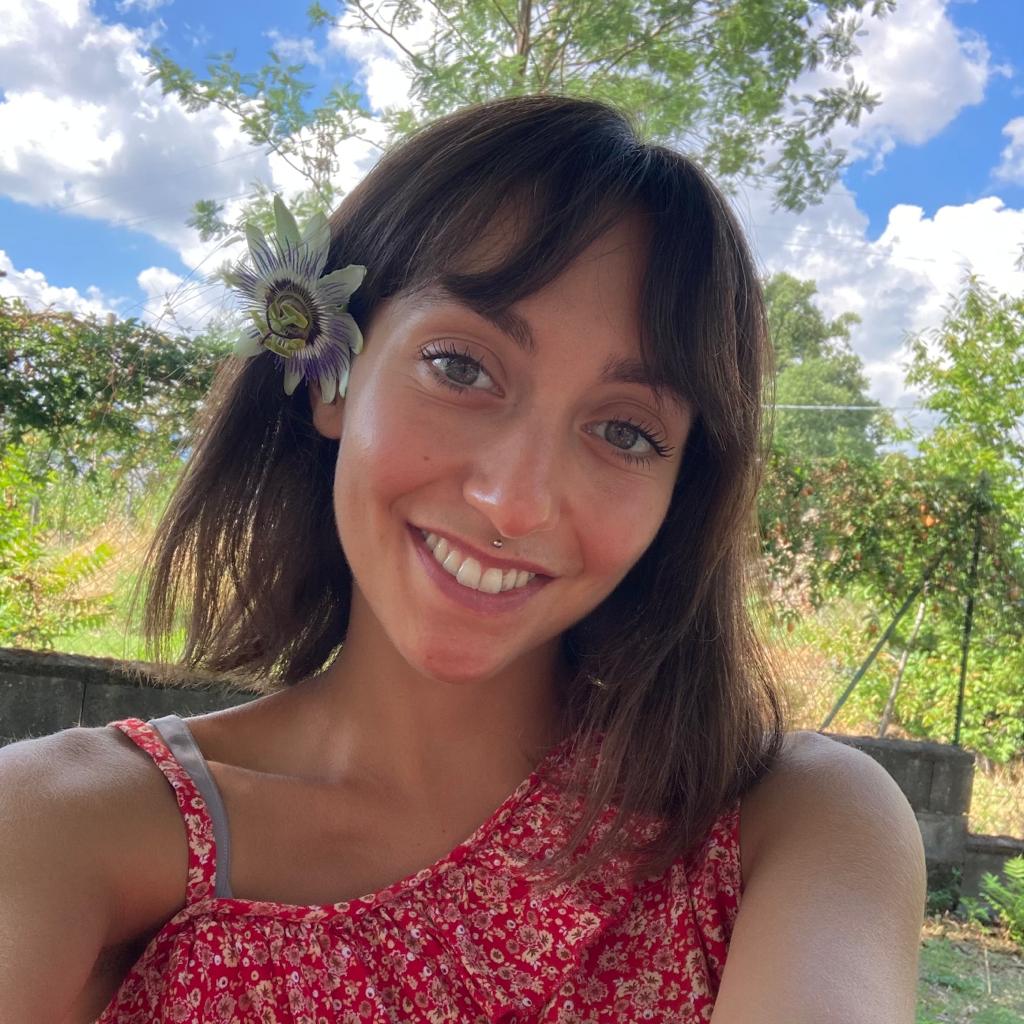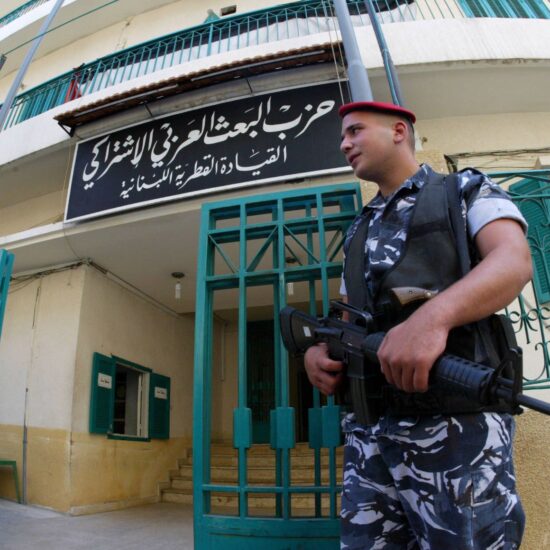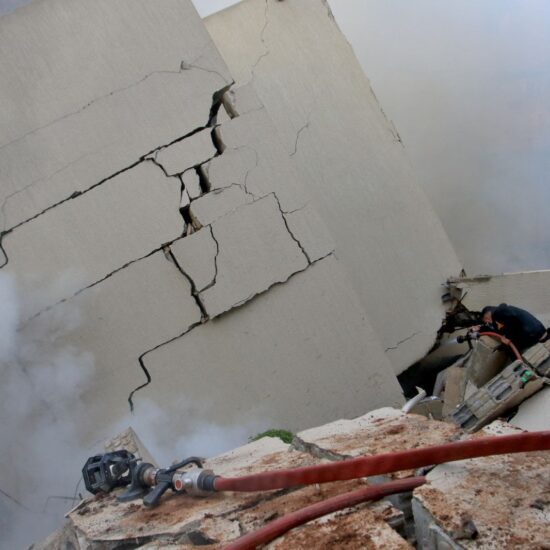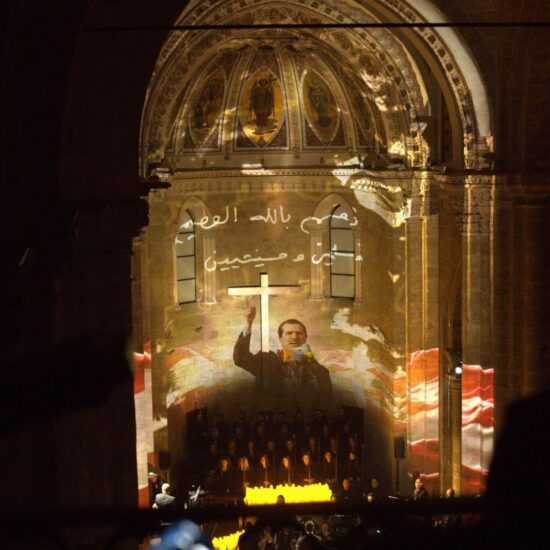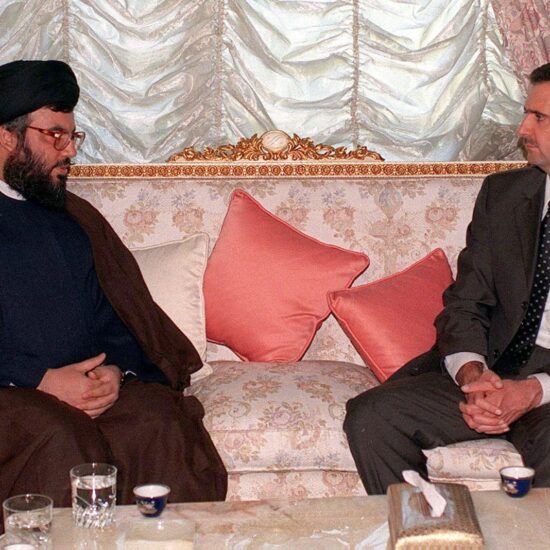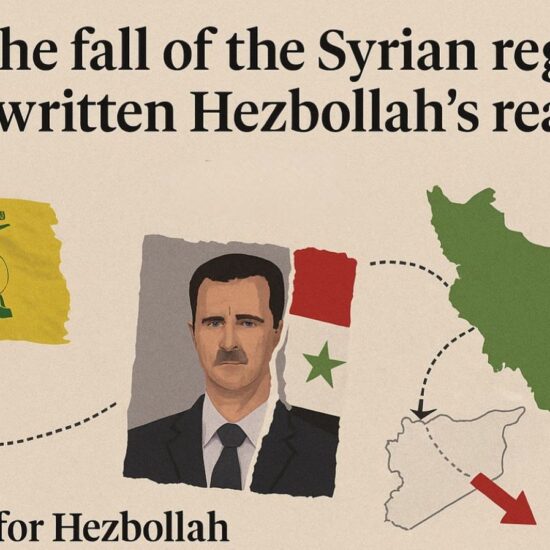
In a Syria where politics had been slowly assassinated, the tireless efforts of bringing it back to life are giving their fruits. A long conversation with Dr. Najib Ghadban on return, darkness, the staticity of time, and the longest exile
He is so attached to Damascus, to his Damascus, Najib Ghadban, that agreed on the time of our call – two o’clock Lebanese time – I from Beirut, and he from Riyadh, 71 days and nine hours after the fall of the Assad regime, the last February 17, my mobile phone rang at one o’clock. “I am sorry,” he says in an immediately affable voice – the same as many of the Syrians I have come across over the years: “I didn’t actually know there is an hour difference between us, because it’s the same time zone with Damascus here, so I assumed Beirut would be the same.” And so, projected onto the common centre of our virtual meeting – a renewed centre, which for the first time can be pronounced conjugated to the future: Syria – I could not help but start with personal questions, the reception of the news of the liberation, the preparation for the encounter with the present, the long-awaited confrontation with the long exile – and him answering, perhaps for the first time in forty-four years, without fear, and with open words. “I usually don’t run away from personal things, and especially now that we have a free country.” No fear in pronouncing revolution, atrocity, justice; no doubt in saying hope: the only embarrassment, the one, normal, of revealing one’s age.
Being Syrian has once again become a normal condition. “It was long,” comments Najib, the broken voice of one who has been waiting all his life for the fulfilment of a dream shattered continuously over thirteen years, and suddenly fulfilled in just eleven days: “and all Syrians deserve it,” he continues. This is the extraordinary revelation two months after the already historic December 8, “at 5.08 in the morning,” specifies Ghadban, activist, academic, exile, now returnee, originally from the suburb of al-Tall, 12 kilometres north of Damascus. “It is located in the exact north, and if you continue, you reach Sednaya, the infamous Sednaya prison and town” – he laughs. Although tense, it was unthinkable, until 71 days and eight or nine hours ago, depending on the time zone, to be able to laugh after thinking Sednaya. After pronouncing – Sednaya.
And while Najib laughs – of tension or relief – I wonder what the starting point might be for trying to tell this long, painful story – what the caesura, what the end.
“On December 8” – at 5.08 in the morning – “I was in Riyadh, at this time alone, sleeping on the couch, following the TV, I think I overslept by the late morning, when I started receiving several phone calls, saying Damascus is free, Damascus is friendly!”. Eleven days before – and so progressively until the fall of Homs – the most natural way to tell what was happening was to think about where it would stop. “When the military operation, which was actually a deterrent aggression, began, I thought the target was Aleppo, maybe the countryside of Idlib, or areas included in the Astana ceasefire that were bit by bit taken forcibly by the regime. But as Aleppo fell very quickly,” Najib recalls, “I started wondering where it would end. Maybe in Homs, the link between Damascus and the coast, unthinkable to be free without fierce fighting… But it also fell, and peacefully.” So he started realizing Damascus could have been the next. “I’ve had a hint, or maybe the knowledge, that things were not quiet in the north-west, ongoing shellings by the Russians kept on hitting opposition areas, and clashes were undergoing around Idlib. Thousands of people have been forced to flee that area, only in the last year and a half, because of this constant tensions, which most of the time took the shape of one-sided bombardments.”
The longest exile
His original town, al-Tall, used to count 810 thousands residents: but for years has been hosting hundreds of thousands of internally displaced, the nasihin, for in the very early days of the revolution, the Free Syrian Army made arrangements with local notables to evacuate, so the town would not be attacked. “Surprisingly, the arrangement stayed,” Najib comments. “When compared to the level of destruction in Darayya, Homs, Douma, you really have the feeling al-Tall has been blessed.”
Of the childhood home – three floors of which only one has been completed, and the typical unfinished stories of interrupted lives – remains what the Ghadbans left behind an immeasurable time ago. “The last time I said goodbye to that house it was 1980, just out of high school.” He thought he would be away for a couple of days, maximum a few weeks. “Just like everyone else,” he counters, so anchored in his own claim to normality: as if, in order to confront the vastness of the emptiness that half a century of exile digs into a persone, one finds himself forced to diminish its impact, reduce its scope, redefine its limits within those acceptable to a man’s mind.
“I had to flee because three of my best friends were arrested, and remained in prison for 11, 17, and 24 years respectively. Going back was simply impossible. And because my family was affiliated with the opposition, the regime refused to renew my passport, and so, officially since 1984, my right to return was revoked.” He would only become an American citizen in 1990, able to travel anywhere in the world except Syria: thus making the denied homeland the cause of his activism, the topic of his research, the subject of the university courses he taught. Everything – without ever ceasing to call it watani, my country.
“I never stopped writing about and acting for Syria,” states Najib, appointed as the Syrian Coalition’s Special Representative to the US. “I was part of the Damascus Declaration, a statement of unity by Syrian opposition figures issued in October 2005; later on, with other colleagues I founded a small group in Washington DC that would have become the Syrian National Council, to promote democracy and human rights in Syria: so that when the revolution began, I was able to take part in almost all the meetings abroad to form an opposition platform.”
And then that day came, that of the journey – from abroad – home. A warm December, a bus from Amman to Damascus, early in the morning, full of refugees finally turned into returnees, of fellow citizens openly recounting their epics. “People were asking each other how long they’d been exiled for, and most of them would answer in the figure of ten, thirteen years. I couldn’t hold myself: forty-four years, I said. Yet no one looked surprised.” Everyone was probably silently asking themselves the same question: if even the house was spared, and a few family members survived, would returning be enough to cushion the void of exile? To bridge the gap of incommunicability about what has been, compared to those who have remained – aged, those who do not notice the darkness, the dusty old cars, the stench of petrol, the decaying buildings – out of normalization? Those who normalized – hunger? Could the return be enough to find the courage to knock on a door one thinks he knows, and introduce himself to members of his own family – an entire generation – who have only met by video call, and for the few minutes the poor connection has allowed, over the last twenty years?
The day after never came
The Day After project (TDA) was born as an attempted answer to different questions compared to those that Najib and the other passengers on the Amman-Damascus bus were asking themselves. At that time – it was late 2011, and on the wave of the Arab springs, Syrians were expecting their turn to come to bring a democratic regime change in the country – conversations in the opposition realm would focus around accountability, representation, and law reforms.
Dr. Steven Heydemann – back then the vice-president of USIP, the Washington-based Institute for Peace – as a non-Syrian member, reached out to the opposition in a moment where there were no formal representatives. Even with the help and support of other countries, in fact – a German think-thank provided them a physical space to meet, to avoid being perceived as a mere American project, “which we were not,” Najib specifies -, the main issue remained internal: what they meant by democratic governance, rule of law, how to translate those slogans into detailed programs.
The early members of the board – Salam Kawakibi, Afra Jalabi, Murhaf Jouejati, and others – worked on a document, released in August 2012 and titled ‘The Day After: Supporting a Democratic Transition in Syria’, which provided a detailed framework of principles, goals and recommendations from a diverse spectrum within the Syrian opposition – including senior representatives of the Syrian National Council (SNC), members of the Local Coordination Committees in Syria (LCC), and unaffiliated opposition figures from inside Syria and the Diaspora – to participate in an independent transition planning process. They addressed fundamental challenges in six key fields: rule of law; transitional justice; security sector reform; constitutional design; electoral system design; and post-conflict social and economic reconstruction.
“You have to understand,” Najib explains, “that in those early, optimistic days we had in mind that we did not know how the regime was to change, there was a possibility for us that it could be negotiated through transition. That’s why we could talk about the security sector reform, a new constitutional and electoral design, etcetera. Our aim was to foresee how to address the major challenges in the first moments after the fall of the regime, that we expected would, if not collapse, at least change anytime, anyday. Soon, however, the main problem became that this long-planned day after was never coming.”
TDA has since shifted its focus from transition planning efforts to implementation of recommendations presented in the report, opening its office in Istanbul to support this mission. “By that time the Syrian National Council was increasingly active, so we recruited a lot of Syrians, from both inside and the Diaspora.” It was the former ones, who stayed in Syria and took incredible risks in attending the TDA meetings, and then went back, who realised things were not evolving: but rather crystallizing around the forcible power of the Assad. “Once they saw nothing was changing, after months, and then years, they started conducting some public opinion surveys, focused on different areas related to the democratic transition: supporting the survivors of arbitrary detention, training activists, tackling displacement, recording HLP rights’ violations, embracing a heritage protection initiative. With this new approach, we could maintain the continuity of the project: without ever feeling stranger to our country.”
The assassination of politics
With representation, came disagreement. “A lot of people left along the way. What we aimed to do, with the report of 2012, was at least to set the lowest common denominator to create consensus around, it was a hard exercise,” he admits, trying to provide an answer to the most provocative of my questions: the one regarding the challenges of the present, how the disagreement of we can now call ‘the day before’ reflects in the new Syria’s political discourse. “You know,” Najib continues, “one of the challenges we, Syrian activists, have always faced is to find ways to debate all of these issues in a very non-political society. The Syrian regime, being so authoritarian, so despotic, so criminal, managed to kill politics.”
“I still recall how much it surprised me to realize, for the first time, that the ones of our colleagues who were active in Syria, and who were later imprisoned, then released, and managed to leave and move abroad, lacked the political experience, the awareness, and even the knowledge of the regime we thought they carried: for the simple fact of being based inside. But this was not the case. One of the practices of the regime was to isolate Syrians from each other, to deepen the divides that exist among us: religious, sectarian, regional, ethnic, call them as you’d like. It wasn’t easy forming consensus and agreement from all these different perspectives.” And I add: assassinated the possibility to speak politics, the space to speak politics, the capability, the language – also the power to imagine it slowly faded away.
And a change of regime does not necessarily entail the rise of a new idiom: just as the dissolution of previous institutions does not automatically lead to the formation of new, uncorrupted ones. Literacy – including political literacy – must be sought, planned, disseminated, and finally defended. The opposition, the new oppositions, listened to, spurred on, and not isolated; the minorities that for fifty years have lived in the false illusion of being protected, integrated without annulling their specificities, nor silencing their demands. “What was positive and healthy in these endless years was the exponential proliferation of civil society organizations outside Syria, thanks to which the diaspora community – and especially the youth – was heavily trained in capacity building and working with local governments’ administrations, so that as many of them are now returning” – some without memories, having left the country in a very young age – “they are able to cooperate with local governors. We are witnessing a moment of lively debate taking place, the regime is gone, and new opportunities to build a country are rising: this time, it seems, for real.”
A return in darkness
“It is interesting to see that most of the challenges we were envisioning to find, when working on The Day After, are actually the same happening now: that is what any country that goes through this kind of transition faces. For example, when working on the project in Germany, we hosted six months of meetings with experts from areas that faced similar problems when going through comparable processes. They gave us a frame of reference, cases to relate to, like that of the Iraqi constitution, or other reforms of their electoral laws.”
Continuing on the issue of major challenges, Najib seems to have no doubts that maintaining law and order was the first one encountered. Yet the current administration, led by former HTS movement (Hay‘at Tahrir al-Sham), could avoid the bloody outcomes of a violent transition, mainly due to the easy surrender of the regime, the absence of any form of resistance by the late Syrian army. “As far as the security sector’s reform is concerned, we were looking for basic changes, but we found out the Syrian army was so exhausted, that it turned out only to be a matter of collecting weapons.” Then, he specifies: “I am only talking about the last eleven days of events, clearly the fourteen years that preceded them were not peaceful at all.”
And now that a roadmap for political transition had been discussed, established a committee for national dialogue – that Najib hopes will take into consideration some of their ideas, in the day to come; now that all armed factions are being dissolved and likely unified into a national army; and in the politico-philosophical dilemma between what is safe and what is right, it seems Al-Sharaa opted for peace, diplomacy and normalization – on all sides -, the people, the Syrian people – the displaced, the survivors of forced imprisonment and torture, the families of martyrs and the disappeared – are still pressuring for justice. Which in most cases takes the form of a battle for infrastructure, housing, light.
“When I went back to Damascus, I wouldn’t expect it to be that bad. Relatives have been telling us about the continuous electricity cuts, energy for two hours a day, the cold, the darkness. Yet I could not believe it. Just as everything seemed to stay the same, during the day, at night it all changed,” he admits. “It was, indeed, a return in darkness.”
Return is a privilege that does not depend only on a change of regime, on the security of not being arrested at the border: security is a right that does not derive only from the orientation of the government in office, from the orders imposed on a tired army. Even now that the army is friendly, as Najib’s friends shouted to him over the phone, waking him from his torpor on the morning of December 9 – the still-deploying day after -, without a real improvement in the quality of services, without light, in Damascus, that road to the rear is difficult to travel: even to imagine.
“When we issued the document in 2012,” explains Najib referring to the first report released by The Day After, “there were maybe tens of thousands of refugees, hundreds of thousands of internally displaced. In 2020, figures reached six million refugees, and more than seven million internally displaced. This is one of the major challenges that require a lot of help and support from neighbouring countries and the international community.” Even though today there is more will, among both the current administration and the displaced Syrians, to go back – and he adds: “what is not said about return under Assad is that he did not want us to go back, as we, the exiled, were mainly members of the opposition” – the process is still far from being safe, and surely it needs to remain voluntarily.
“Whole cities are completely destroyed, think of Homs, parts of Aleppo, Deir ez-Zor, the suburbs of Damascus. Darayya is hundred percent reduced to ashes. And even though 800,000 internally displaced have already been back to destroyed homes, trying to rebuild with the scarce, available resources, for people abroad, especially those with a source of income, it will take longer: at least until the new Syria will be able to provide basic infrastructure, electricity, fuel, viable roads.”
But there’s another obstacle obstructing the path of return, for those who are willing to walk it: which is the confiscation of properties. In an attempt to ensure control of opposition areas and restructure the demographic makeup of the country, the Assad regime has passed legislation – including Law No. 10 of 2018 – that threatens the property rights of Syrians internally displaced and abroad. Since then, HLP (Housing, Land, and Property) rights in the Syrian context are no longer solely linked to property ownership, but have become intertwined with fundamental issues such as societal fabric, the right of return, political rights, peacebuilding, and transitional justice: defending these rights, therefore, turned out to be a defense of the Syrian people’s right to democratic transformation and resisting the Syrian regime’s policies aimed at perpetuating displacement and altering the social structure.
By documenting and digitizing ownership records, Najib and the people of The Day After were able to prove that some properties were confiscated by the army, especially the Fourth Division and the Republican Guard, as well as by security agencies, the Air Force Intelligence and Military Security, and a number of sectarian militias, different from one region to another. “Now, also thanks to our and other organizations’ efforts, those properties are being given back to the rightful owners,” he explains. “Yet there will be some serious legal issues for some cases, for example when members of the regime were able to get new documents for the confiscated lands.”
There are in fact other indirect actors involved in what they call ‘the trilogy’ – siege, destruction, displacement – that include administrative and legislative institutions, as well as local institutions such as municipalities and city councils, and central ones such as ministries, the People’s Assembly and the Presidency, in addition to networks of private institutions and individuals linked to the regime. However, while the military arms of the regime committed violations in the direct procedural sense, the legislative and administrative institutions were able to provide a cover and give legitimacy for these procedures through laws, decisions, zoning scheme and other means, further complicating, through this infamous integration, the situation for any attempts to dismantle the issue of HLP rights in Syria. While all information about the practices of the regime’s military agencies, which have the largest role in violations, were absent, though, legislative and administrative institutions have been the ones visible in the public sphere, whose laws, decisions, and projects became almost the only subject for the work of researchers and observers.
That is why several efforts to document, denounce, call the international community’s attention on the regime’s legislation on property rights and their implications for Syrian citizens were made over the years, when TDA’s work shifted, from planning and reforming, to monitoring and advocating: asking the bystander world not to leave them behind. It is worth mentioning, in this regard, the policy paper ‘Intervention Policies to Address Informal Settlements’ – providing an in-depth analysis of the informal settlements issue in Syria, from its roots to its worsening over time; the study ‘Investment of Confiscated Funds, and a New Episode of HLP Rights Violations – A Study of Law 26 of 2023’ – discussing the confiscation of properties through exceptional court rulings, as part of a series of laws issued after 2011 designed to punish opponents and reward supporters, by transferring ownership of confiscated properties to public entities, preventing rights holders from reclaiming their properties in the future; or the statement ‘A Familiar Yet A New Step by the Syrian Regime to Seize Displaced People’s Properties’ – concerning the 2022 organizational plan for the Jobar neighbourhood in Damascus, an old new attempt to seize the properties of millions of displaced Syrians, as most residents of the areas included in the plan have become internally displaced or refugees, hence unable to object to the organizational plans or prove their ownership within the short time granted: only one month.
However, without detracting from the extraordinary potential of thirteen years of tireless archiving and documentation work, there were little field studies examining the reality of practices, patterns of violation and their impact – beyond the theoretical framework, and extended to all Syria. Questions regarding exchange of properties due to displacement, destruction of municipal archives and agencies such as the Hajr Aswad court, completely burned down, or the sensitive issue of the return for Palestinian former refugees in Syria – and the trajectories of their right to return – are still open, as a rightful matter of yet another following day, that of everyday life starting from now, of lit streets, crowded markets, heating in homes – and doors and windows -, dignity, getting out from the breaking news, turning back to normality: the most radical of all transitions.


